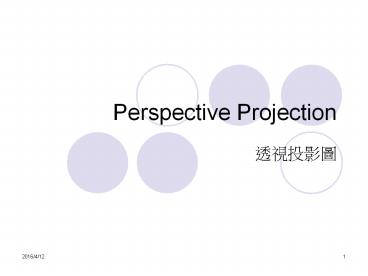Perspective Projection - PowerPoint PPT Presentation
1 / 22
Title: Perspective Projection
1
Perspective Projection
- ?????
2
Perspective Projections ?????
- Perspective drawing differs from axonometric
projection oblique projection in that the view
is projected onto the picture plane by
non-parallel projection lines merging to a single
point called the station point (SP) - SP can be regarded as the position of the
viewers eye
VP
EL
3
Vanishing Point
- A point in a perspective at which a set of
parallel lines appear to converge - Each set of parallel lines has its own vanishing
point
4
Convergence Principle
- Lines perpendicular to the picture plane appear
to converge on the horizon line at the centre of
vision - Lines parallel to the picture plane DO NOT
converge to a vanishing point but decrease in
size according to their distance from the viewer
5
One-point Perspective
- 1 vanishing point
- 2 axes or 1 face is parallel to the picture plane
(PP)
6
Two-point Perspective
- 2 vanishing points
- 1 axis of the object is parallel to the picture
plane
7
Three-point Perspective
- 3 vanishing points
- None of the axes is parallel to the picture plane
8
Drawing Perspective Box
- Product sketching usually set the vanishing point
far away from the drawing boundary, the result is
an object that look small to medium size - Draw 3 sets of parallel construction lines, 3
lines per set. Longer lines make checking easier - Draw the actual outlines with thicker, more solid
lines - Shade or render to taste
9
Drawing Perspective Box
- Bringing the vanishing points closer to the
drawing boundary, the result is an object that
look more stereoscopic - Draw 3 sets of construction lines, 3 lines per
set. - If the form sits upright
- the imaginative vanishing points for the first 2
sets of line should line up horizontally - the third set of line should be vertical
- Longer lines make checking easier
10
Viewing Angle and Edge Pairs
Incorrect perspective the imaginative vanishing
points does not line up horizontally
Looking from high abovethe imaginative
vanishing points high above the sketch
Object tilted the 3 sets of edge rotate together
Looking from horizon the imaginative vanishing
points slightly above the sketch
11
Common Errors
- All edges of the same direction must converge to
one and only one vanishing point - The vanishing point must locate at the side away
from the viewer - Hidden lines when extended, should intersect box
corners
12
View Angle and Visual Illusion
- For forms with inclined elements or edges on the
faces, the effect of visual illusion can be very
distracting, ending up with what looks like a
very mis-shaped object - The effect can be avoided by selecting another
view angle
13
(No Transcript)
14
Drawing Perspective Circle
- Perspective circle is not a true circle
- The first step to draw perspective circle is to
draw a perspective square - Divide the square with a cross
- Draw an ellipse with the long axis and short axis
align to the diagonals
15
Perspective Circle in Different Orientation
16
Side-track Axonometric
- Axonometric projections have many variations
- Some have different levels of distortion among
the different faces - Some may have one of the sides with no distortion
at all - If the angles among X, Y and Z axes are the same,
i.e. 120 degrees, emphasis is given to all the 3
sets of planes. This type of projection is called
Isometric
17
Constructing Complex Form
- Imagine the faces as skewed drawing board
- The internal construction lines on the faces
should match as they do in real-world - Always draw construction lines on hidden faces to
determine location of elements
18
Starting off with the Cubic Form
- The cube is a convenient starting unit to
construct other geometric forms
19
Variations of Geometry
- Additive Forms
20
Variations of Geometry
- Subtractive Forms
21
Variations of Geometry
- Other Complex Forms
22
Side-track Foreshortening
- Foreshortening refers to the contraction in size
or length in the direction of depth in a
perspective drawing for creating an illusion of
distance or extension in space - Such a phenomenon occurs when an object appears
compressed when seen from a particular viewpoint,
and the effect of perspective causes distortion. - The orientation of the central axis of vision
relative to the object determines the degree of
foreshortening of individual spaces - The more a plane is oblique to the picture plane,
the greater degree of foreshortening occurs - Only when a plane is parallel to the picture
plane (as in orthographic projection) can its
true shape be revealed - For complex shapes, the effect of foreshortening
can be very difficult to achieve convincingly,
ending up with what looks like a very mis-shaped
object. - The linchpin is OBSERVATION and PRACTICE!































